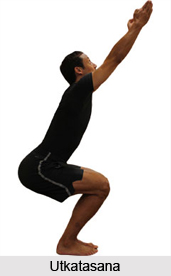 Utkatasana is a cultural yoga asana that strengthens the muscles of the abdomen and the thighs, performed as a crouch while on tiptoe.
Utkatasana is a cultural yoga asana that strengthens the muscles of the abdomen and the thighs, performed as a crouch while on tiptoe.
Meaning of Utkatasana
The literal translation of the word "utkatasana" from Sanskrit is "powerful pose." Utkatasana helps the practitioner find the seat of power within the pelvis, at the center of the body. Also known as the chair pose, it works on the muscles of the arms and legs, but it also stimulates the diaphragm and heart.
Practice of Utkatasana:
* Stand erect, legs together hands by the side of the thighs. Gaze in front.
* Place legs about one foot apart. Raise the arms straight in front up to shoulder level, palm facing downward.
* From a standing position, step your feet hip-width apart so you feel grounded and connected to the width of your pelvis. On an exhalation, squat down from here as if to sit in a chair, keeping your heels on the floor.
* Raising the heels, stand on toes and slowly sit putting weight on toes.
* Put both hands on respective knees.
* On an inhalation, come up to standing and take a few cycles of breath to rest your thighs.
* Shift and center your weight so that your knees come over your ankles. Now extend your arms directly out in front of you with your palms facing each other, and then take them overhead in direct alignment with your shoulders.
* After sometime, while returning, raise your arms from the knee up to shoulder level.
* Keeping balance, stand erect on the toes, there after, slowly place the heels on the ground.
* Bring hands by the side of the thighs and keeping the legs together return to the original position.
Effects of Utkatasana
* Calf muscles are made healthy and remove constipation and nervous weakness of the lower extremities.
Precautions in practice of Utkatasana
Those suffering from muscle pull, headache, insomnia and low blood pressure should not practice it. This is a balancing pose, therefore, maintain balance while sitting or standing on toes. During final posture, upper part of the body must remain erect. Do not put weight on heels.
To stay in this pose, perform it near a wall. Stand with back to the wall, a few inches away from the wall. Adjust position relative to the wall so that while bending into the position, the tailbone just touches and is supported by the wall.




















